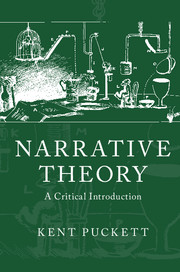Book contents
- Frontmatter
- Contents
- Acknowledgments
- Chapter 1 Introduction: Story/Discourse
- Chapter 2 Action, Event, Conflict: The Uses of Narrative in Aristotle and Hegel
- Chapter 3 Lost Illusions: Narrative in Marx, Nietzsche, and Freud
- Chapter 4 Epic, Novel, Narrative Theory: Henry James, Georg Lukács, Mikhail Bakhtin, and Erich Auerbach
- Chapter 5 Form, Structure, Narrative: Propp, Shklovsky, Saussure, Lévi-Strauss
- Chapter 6 Narratology and Narrative Theory: Kristeva, Barthes, and Genette
- Bibliography
- Notes
- Suggested Further Reading
- Index
Chapter 1 - Introduction: Story/Discourse
Published online by Cambridge University Press: 01 December 2016
- Frontmatter
- Contents
- Acknowledgments
- Chapter 1 Introduction: Story/Discourse
- Chapter 2 Action, Event, Conflict: The Uses of Narrative in Aristotle and Hegel
- Chapter 3 Lost Illusions: Narrative in Marx, Nietzsche, and Freud
- Chapter 4 Epic, Novel, Narrative Theory: Henry James, Georg Lukács, Mikhail Bakhtin, and Erich Auerbach
- Chapter 5 Form, Structure, Narrative: Propp, Shklovsky, Saussure, Lévi-Strauss
- Chapter 6 Narratology and Narrative Theory: Kristeva, Barthes, and Genette
- Bibliography
- Notes
- Suggested Further Reading
- Index
Summary
We tell ourselves stories in order to live.
Joan Didion, “The White Album”There are lots of ways to think about narrative theory. We might consider the countless casual interactions people have with books, movies, news stories, stump speeches, comics, conversations, and rumors. Whenever someone (on the phone, in a book club, online, or in line at the store) talks about a story's beginning or end, its pacing, the believability or the likability of its characters, he or she is engaging in a kind of narrative theory, an effort to understand particular narratives in relation to assumptions and expectations that govern either some kinds of narrative or narratives in general. We might also consider more professional efforts to understand or to evaluate narratives, the work and writing of critics and academics who make their livings assessing or analyzing stories either in terms of particular aesthetic, social, or political values or in terms of the expectations and ideas that circulate at a given moment in time. We might think here of the film critic who sees every film in a season and so can say with authority what films work best and why; or of the think-piece blogger who looks at a handful of contemporary novels in order to see how the war on terror or the new ubiquity of social media affects the way we tell stories now; or of the literary critic who reads Renaissance drama or Victorian fiction in order to identify how history's different ideas and practices shape the form and content of narratives (how Elizabethan stage design limits or conditions the beginnings and ends of plays, how serialization affects thinking about suspense, how culturally specific ideas about death and dying affect thinking about the possibility of closure, and so on). These are also theories of narrative, attempts to understand both the role that narratives play in particular cultures at particular times and the shaping effects that a culture's assumptions and beliefs have on the development and evaluation of narrative as such.
A third kind of narrative theory is the subject of this book. Narrative theory in this more limited sense names a more and less coherent intellectual tradition that works explicitly to understand the general rules of narrative alongside the many particular forms that narratives can take.
- Type
- Chapter
- Information
- Narrative TheoryA Critical Introduction, pp. 1 - 23Publisher: Cambridge University PressPrint publication year: 2016



